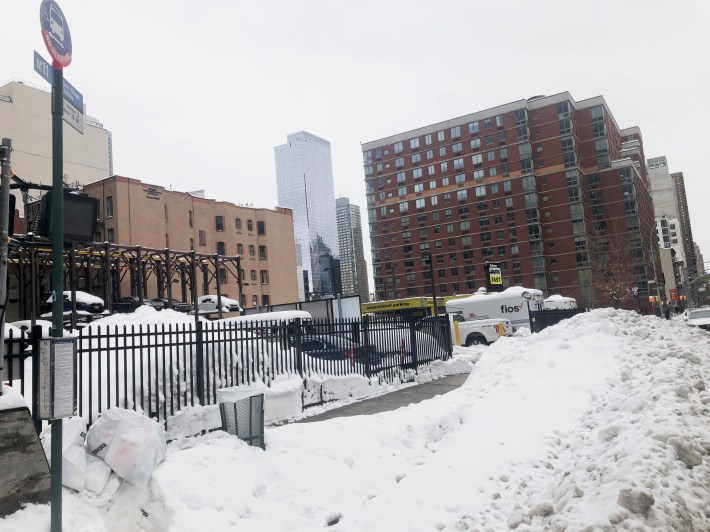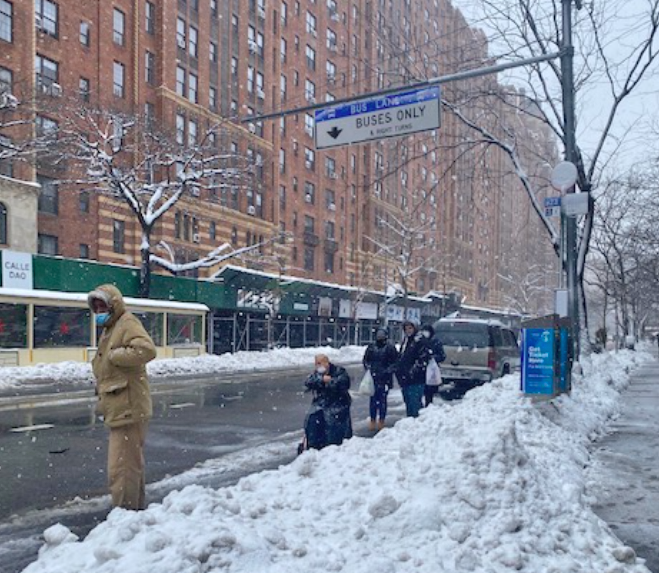
If you ever needed confirmation, recent snowstorms showed once again that there is no equity between drivers and pedestrians/bus riders/cyclists in New York City. All lanes of vehicular traffic for cars were cleared of snow in 12 hours, while bus stops, bike lanes, corners and sidewalks were impassable. We should not be surprised: the New York City Sanitation Department calls its mission “restoring the blacktop."
So — one week later — entire sidewalks and bike lanes are still submerged under snow and no one is bothering to even inspect the situation: 311 refuses to accept complaints about snow (which is a sure way to eliminate problems!). With so many stores closed, the situation is dire for public transit riders, first responders, seniors and people with disabilities and the vast majority of the population that does not drive.
Foolishly planned to use the Central Park West bike lane but it's just a sea of NYPD vehicles blocking both bikes and plows #bikenyc @StreetsblogNYC pic.twitter.com/SgMDGPbdnP
— rbellinger (@rob_bellinger) February 21, 2021
Today, the taxpayers pay for DSNY to clear the roadways. Although bike lanes are part of the roadway, they require smaller trucks which are few and far between in the DSNY fleet. Clearing the sidewalks is entirely the responsibility of businesses and residents, who are unlikely to clear a consistent pedestrian path, corners, pedestrian crossings and bus stops or to receive a fine if they do not comply. Areas adjacent to parks or MTA are the responsibility of those agencies, subject to negotiation.
There are so many good reasons to change the way the streets are cleared of snow in New York City.
- First, it violates the American with Disabilities Act. Maintaining the sidewalks during snowy weather is never optional according to the ADA: “Reasonable snow removal efforts are part of the public agency obligation to maintain its Walkways in an accessible condition, with only isolated or temporary interruptions in accessibility." Throughout the city, snow pileups are not “isolated or temporary” for people with disabilities — they are a persistent hazard!
- Second, it is dangerous: in our era of Vision Zero forcing people to walk in the street, while at other times we penalize pedestrians for walking in the street, is absolutely wrong. And there is ample evidence that citizens are not happy about the current state of affairs: during the last snowfall, a tweet asking, ”Why do we treat cars better than people” garnered 18,400 likes in no time at all for its poster, @JBlascoNYC.
Why do we treat cars better than people? pic.twitter.com/Gjm2TgAFDy
— John M. Blasco (@JBlascoNYC) February 2, 2021
- Third, you cannot fine your way out of the problem: “There are people who simply can’t adhere to shoveling ordinances, like those who are elderly or disabled, and single parents working multiple jobs,” Bloomberg news mentioned in a 2019 story. And now with the COVID and retail crises, many storefronts may remain empty for years to come, perpetuating a patchwork of impassable sidewalks.
- Municipal snow clearing from sidewalks is not an outlandish concept: many cities and states do it. Stockholm clears all its major arterials prioritizing bike/ped facilities to address equity concerns, Fast Company reported. In the United States, a 2013 survey of 33 state DOTs showed that 49 percent of those states did clear sidewalks (to some extent, based on various criteria). Such states include Connecticut, New Jersey, and Pennsylvania. Also:
“Although most cities don’t treat sidewalks as necessities, some do, and prioritize them to varying degrees. Most sidewalks in Toronto are cleared by the city. In Rochester, New York, the city steps in when snow totals reach more than four inches. Rochester pays for removal through an 'embellishment fee' on property-tax bills, which averages $35 [annually] per homestead. Duluth clears 100 miles of priority sidewalk routes, including routes to schools, high-pedestrian traffic locations, and public-transit locations. Bloomington, Minn., clears all of its 250 miles of sidewalks. These cities’ programs could act as templates for New York to formulate a plan for safe pedestrian paths in the winter,” the Bloomberg story said.
@nyc311 #beltparkway #Brooklyn #bikenyc greenwway still unplowed and completely covered with snow, heard @NYC_DOT iss responsible? pic.twitter.com/MCNAioreN3
— BikeNYCPotholePatrol (Official) #StopBreakingGlass (@cyclenyc) February 20, 2021
The New York City program must get Emergency services back on cleared roads ASAP and restore public transportation in priority. To facilitate the work of DSNY, vehicular traffic would be restricted to emergency vehicles and High Occupancy Vehicles for the duration of the storm and for two days after.
To clear the streets/sidewalks equitably, a new protocol for snow removal is required.
- Create a network of safe access for emergency vehicles and bus route by clearing one lane on each arterial (bus lanes and others)
- What is the point of clearing a bus lane if passengers cannot get on the bus? As a second priority, the city would clear bus stops, corners and sidewalks. A simple operational change will make this much easier: on arterials, plows should push the snow to the left rather than to the right. As a result, there would be minimal accumulation at bus stops and street corners. Snow would instead be piled in a car lane (given that drivers are being discouraged from driving anyway, they won't miss the space).
- Snow must be removed from bike lanes after sidewalks are cleared. This prevents bike lanes being re-buried by the sidewalk snow removal. Snow from bike lanes gets pushed onto parking lanes and not the cleared sidewalks.
- Lastly, the remaining car lanes on arterials would be cleared.
The majority of vehicles on the road are SUVs, trucks and 4X4 and navigating snow is no longer a challenge for them. It is common practice elsewhere for cars to have snow tires. Driving is restricted to vehicles equipped with chains, 4-wheel drive transmissions or snow tires. Taxis, Ubers and limos would be compelled to use those.
Many additional interventions could make this process more efficient: marking the street in red where buses stop on the road prevents snow pile-ups there ; trucks follow snow plows to pick up accumulation; spray sidewalks and bike lanes in advance with brine to reduce accumulation.
In the end, it is a matter of equity and common sense: pedestrians and cyclists are at much greater risk when it snows. And why are millions of non-driving citizens who are the majority of New Yorkers paying taxes to clear streets for cars, while certainly not getting the same level of service.

Christine Berthet is one of the founders of CHEKPEDS, the Clinton Hill/Hells Kitchen pedestrian advocacy group. She is also a member of Manhattan Community Board 4. Follow CHEKPEDS on Twitter @chekpeds.






